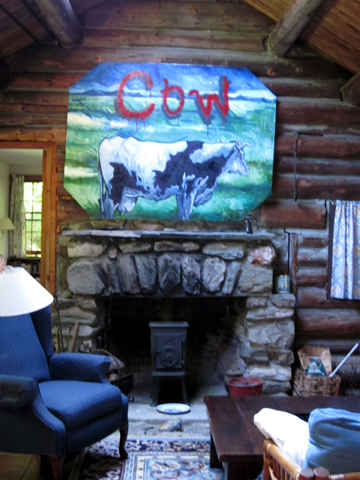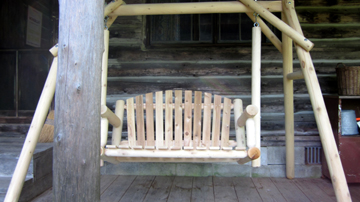1/2 cup tarragon leaves
Makes about 1 quart of vinegar.
If you enjoyed this post, please consider taking out an email subscription to my blog. Just click on the link below!
Makes about 1 quart of vinegar.
If you enjoyed this post, please consider taking out an email subscription to my blog. Just click on the link below!
My family rented Alice’s Cabin every summer from the time I was four until I was 21. The cabin is set in the woods, way down a curvy dirt road.
Alice’s Cabin perches right above Singing Brook Farm’s dammed up mountain stream and tennis courts—an ideal location for children. We could always see who was available for play.
Everything else I love. So does my mother. So do the dog and cat. The latter has unfortunately retired from mousing at the advanced age of 19; her celestial blue eyes are beautiful but blind.
(Ernie and the cow deserve their own post one of these days. For the moment, let me just say that the cow is hard to miss.)

My own room (used by nephew Michael when he is in residence) is decorated with posters. Two of my favorites are a World War I-era announcement and a blown-up advertisement for one of my singing engagements.
Naturally, when we are at Alice’s Cabin my mother and I spend time down at the Dam. The water is cool—actually, COLD—but refreshing. Jan can’t go swimming unless she has more than one person to help her so sometimes we have to compromise.
I am able to move her chair into the water so that she can cool her feet off. And she often enjoys just sitting near the Dam with Truffle. The air there is always cooler than it is way up on the main road.
Let the syrup cool for a few minutes; then strain it through cheesecloth into a sterilized jar or bottle. Makes about 2 cups.

The newest feature of Alice's Cabin. One can sit on the swing and watch tennis, listen to the rain, or just take a nap.
If you enjoyed this post, please consider taking out an email subscription to my blog. Just click on the link below!

We’re so used to artificial light that we forget how many traditional holidays are based on the cycles of the sun. Easter and Passover (and just about every spring holiday there is) are examples. Both holidays are tied to the vernal equinox. On that welcome day we finally achieve parity between dark and light and start lurching toward the golden days and gentle evenings of summer.
Like the vernal equinox itself, Passover and Easter mix dark and light. That mixture is key to the two festivals. The Jews’ flight from Egypt more than 3000 years ago is meaningless unless one understands the harsh slavery under which the Jewish people served the Pharaohs. The joy of Easter is possible because of the sorrow of Good Friday.
As a food writer and food lover I appreciate the centrality of food to both of these holidays, particularly Passover. Passover illustrates the connection we all feel but too seldom articulate between food and memory. Food is used at Passover to symbolize the history the holiday commemorates and to bring people together to remember this shared history.
The centerpiece of the holiday is the meal known as the Seder, in which families gather to retell the story of the departure from Egypt. Much of the Seder’s menu is prescribed by tradition, and during the meal the symbolism of each item on the table is explained.
A bitter herb (usually horseradish) symbolizes the hardship of the slaves’ life, for example. My personal favorite symbol, Haroseth (also spelled “charoset” and a variety of other ways), is a paste of fruits and nuts. It represents the mortar the Jews used to construct buildings—most famously the pyramids.
Many years ago my honorary Aunt Carolyn Fox brought this haroseth to a Seder at our home in Hawley, Massachusetts. Growing up I ate haroseth moistened with wine. As a lover of sweets I was thrilled with her use of grape juice instead. The last time I made it I used crangrape juice, adding a little New England tang to this Passover staple. Next time I’m thinking of using straight cranberry juice…….
The Haroseth
Ingredients:
2 tart apples, peeled and cored
1/2 cup pecans
1/4 teaspoon cinnamon
1 teaspoon honey
1 tablespoon grape (or crangrape or maybe cranberry) juice
Instructions:
Finely chop the apples and pecans separately; then chop them together to make even smaller pieces. Stir in the cinnamon, honey, and juice.